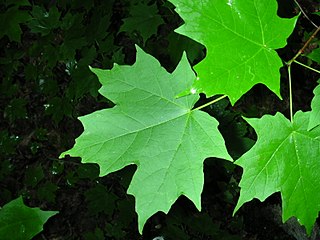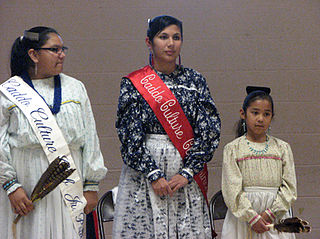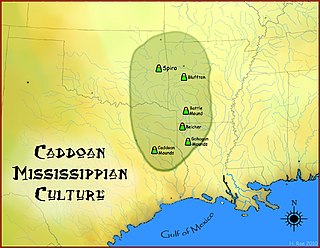
Caddo is a town in Bryan County, Oklahoma, United States. The population was 997 at the 2010 census, a 5.6 percent gain over the figure of 944 recorded in 2000. The name is derived from a Caddo word, ka do hada’ cho, meaning "real chief" in English. According to Encyclopedia of Oklahoma History and Culture, the town was named for the nearby Caddo Hills.

Anadarko is a city and county seat of Caddo County, Oklahoma, United States. The city is 50 miles (80.5 km) southwest of Oklahoma City. The population was 5,745 at the 2020 census.

Jefferson is a city and county seat of Marion County, Texas, in Northeast Texas. It has a population of 1,875 as of the 2020 United States census.

Acer saccharum, the sugar maple, is a species of flowering plant in the soapberry and lychee family Sapindaceae. It is native to the hardwood forests of eastern Canada and the eastern United States. Sugar maple is best known for being the primary source of maple syrup and for its brightly colored fall foliage. It may also be called "rock maple," "sugar tree," "sweet maple," or, particularly in reference to the wood, "hard maple," "birds-eye maple," or "curly maple," the last two being specially figured lumber.

Caddo Lake is a 25,400-acre (10,300 ha) lake and bayou (wetland) on the border between Texas and Louisiana, in northern Harrison County and southern Marion County in Texas and western Caddo Parish in Louisiana. The lake is named after the Caddoans or Caddo, Native Americans who lived in the area until their expulsion by the United States in the 19th century. The US forced most of them to move west to Indian Territory.

The Caddo people comprise the Caddo Nation of Oklahoma, a federally recognized tribe headquartered in Binger, Oklahoma. They speak the Caddo language.

The Caddoan languages are a family of languages native to the Great Plains spoken by tribal groups of the central United States, from present-day North Dakota south to Oklahoma. All Caddoan languages are critically endangered, as the number of speakers has declined markedly due to colonial legacy, lack of support, and other factors.

Caddo Parish is a parish located in the northwestern corner of the U.S. state of Louisiana. According to the 2020 U.S. census, the parish had a population of 237,848. The parish seat and largest city is Shreveport, which developed along the Red River.
Caddo Gap is an unincorporated community and census-designated place (CDP) in Montgomery County, Arkansas, United States. It lies between Glenwood and Norman, on the Caddo River. It was first listed as a CDP in the 2020 census with a population of 39.

Caddo Parish Magnet High School (CMHS) is located in Shreveport, Louisiana, United States. Caddo Magnet was founded by its first principal, Ascension Smith. The school colors are gold and red, and the mascot is a Mustang. The current principal is Mr. Robert Middleton. The assistant principals include Dr. Cedric Ellis, Schannon Lanclos, and Amanda Dolph.

Lake Tawakoni is a 37,879-acre (15,329 ha) reservoir located in Northeast Texas, about 48 miles (77 km) east of Dallas. It lies within three Texas counties, Hunt, Rains, and Van Zandt. It is used for water supply and recreation. It is under the Sabine River Authority of Texas and the original headwaters of the Sabine are converged under the lake surface.

The Caddo Mountain salamander is a species of salamander in the family Plethodontidae endemic to Arkansas in the south-central United States, and only known from the Caddo Mountains, a part of the Ouachita Mountains.
The Caddo are Native American people in United States.

The Caddoan Mississippian culture was a prehistoric Native American culture considered by archaeologists as a variant of the Mississippian culture. The Caddoan Mississippians covered a large territory, including what is now Eastern Oklahoma, Western Arkansas, Northeast Texas, Southwest Missouri and Northwest Louisiana of the United States.

Caddo Lake State Park is a state park located in the piney woods ecoregion of East Texas. The park consists of 484 acres (196 ha) on Big Cypress Bayou, west of Caddo Lake itself, in Harrison County, near Karnack, Texas. The park opened in 1934 and is managed by the Texas Parks and Wildlife Department. There are two separate units, Caddo Wildlife Management Area and Caddo Lake National Wildlife Refuge, nearby.

Caddo Mounds State Historic Site (41CE19) is an archaeological site in Weeping Mary, Texas, United States. This Caddoan Mississippian culture site is composed of a village and ceremonial center that features two earthwork platform mounds and one burial mound. Located on a precontact Native American trail later named by the Spanish as El Camino Real de los Tejas, the settlement developed hundreds of years before the arrival of Europeans to the region. Archaeologists believe the site was created in approximately 800 CE, with most major construction taking place between 1100 and 1300 CE.

Pseudopolydesmus is a genus of flat-backed millipedes in the family Polydesmidae.
Caddo agilis is a species of harvestman in the family Caddidae. It is found in North America.

Caddo is a genus of harvestmen in the family Caddidae. There are two described species in Caddo. Both species are found in North America and Eastern Asia.
Chrysobothris caddo is a species of metallic wood-boring beetle in the family Buprestidae. It is found in North America.















